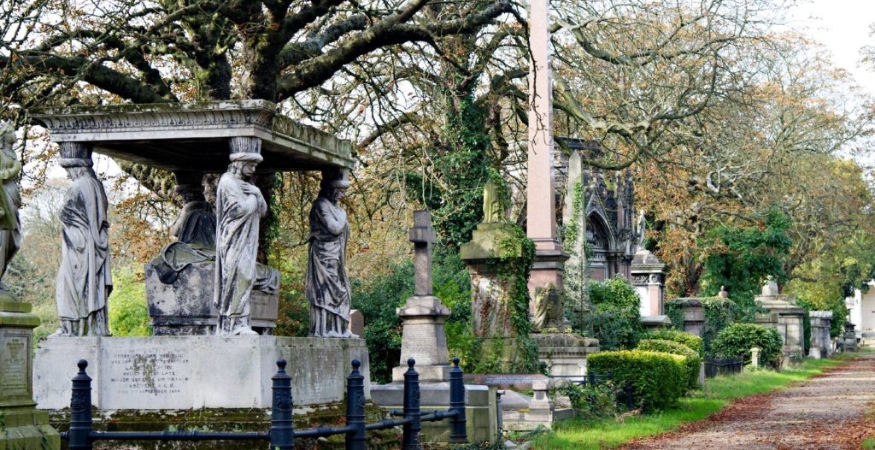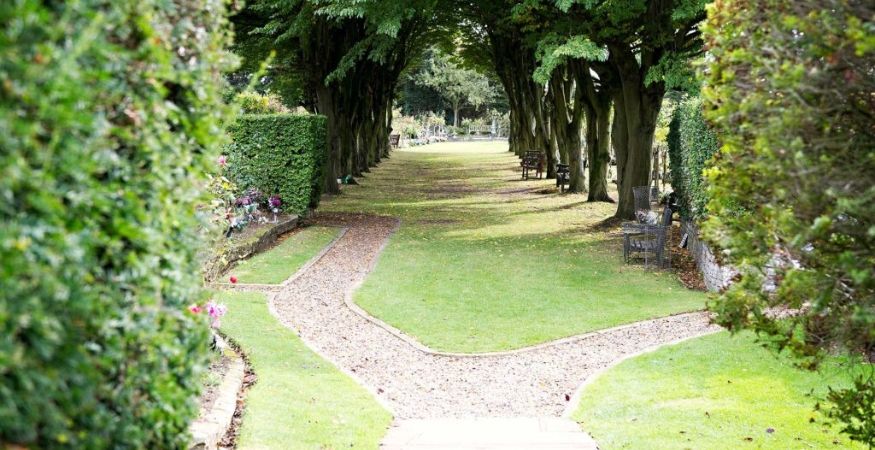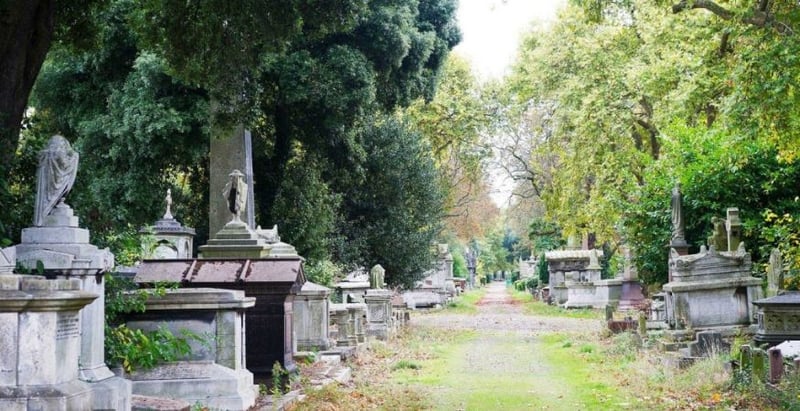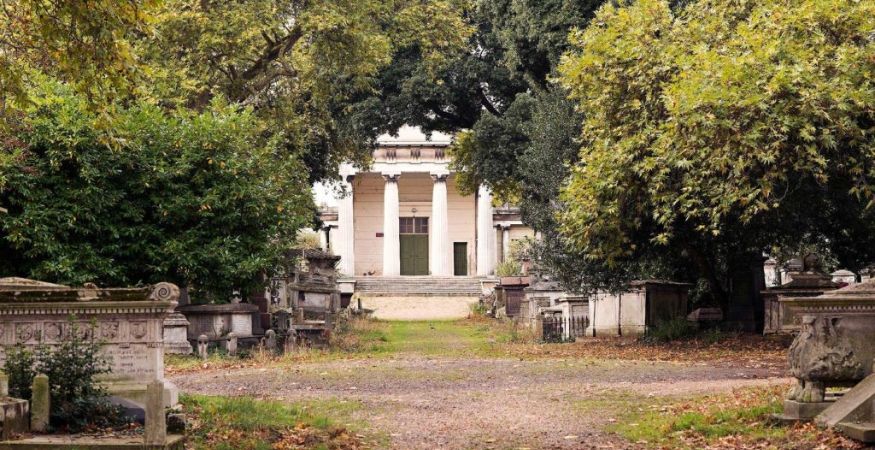Heartwood Preserve Grows with PlotBox
Learn how PlotBox's cemetery management software is helping green burial site Heartwood Preserve to connect families to the locations of their loved...
Discover how one of London's ‘Magnificent Seven’ is preserving it's legacy and protecting its future with PlotBox's deathcare management solution.

We're eager to discover more about your cemetery and explore the possibilities of integrating PlotBox seamlessly into your operations.
Let's Talk| Read time: 10 mins

With many famous residents and a rich and storied history, Kensal Green Cemetery and West London Crematorium hold a special place within the UK bereavement services landscape.
Utilising outdated, paper systems that held data and information stretching back well over a century, as well as being an ongoing concern, it was clear to the senior management team that a change was needed.
We spoke with General Manager and Registrar Kelly Farrington on why PlotBox’s deathcare management solution was the right choice in helping to protect such an important legacy while ensuring long-term sustainability.
I joined the General Cemetery Company in May 2017, initially as the Operations Manager.
Nothing was computerised, and I was brought in to develop the business, to modernise, and to look at all of the processes and procedures that were going on here.
Sadly, COVID-19 hit, and things didn't progress at the speed that they would have otherwise.
In 2021 I was promoted to General Manager and Registrar, at which point my main focus was to drive forward and implement a computerised system.
So now, it's the overall management of Kensal Green Cemetery and West London Crematorium.
It's a 72 acre cemetery, and we also have the crematorium. Currently there are just under 20 staff, and that's broken down to 10 ground staff, and when we're fully staffed, 8 office staff, (which we aren’t currently).
Three of the office staff comprises the senior management team - that’s myself, the head of planning and projects, and a recent recruitment - a deputy manager.
Together, we carry out the running of the business and drive it forward.
Yes, as I say, Kensal Green Cemetery is a 72 acre site and is still open for burials, although grave space is extremely limited.
The site opened in 1833, and is one of London's “Magnificent 7” cemeteries, housing many elaborate and beautiful memorials.
West London Crematorium was built in 1939, and is actually situated within the cemetery grounds. It delivers services to people of all faiths and the crematorium hosts approximately 1,000 cremations per year.
Many areas of the cemetery have sadly been left to overgrow, perhaps, where the graves aren't visited any more.
But in more recent years we've made a priority to clear those sites, uncovering all of the old gravestones.
Sadly, we will never uncover empty areas, and many of the older graves, of course, have very large memorials, which now we just wouldn't allow from a safety point of view.
So it's typical of an old-style cemetery.
Not all of our burial records were computerised, and the ones that were, were only partially completed.
The manual records were always kept up to date, but in some cases are very limited, and in days of old, the depth of the grave was never recorded, meaning that if a family came forward to open that grave, we wouldn’t know whether there was suitable space remaining.
We've been using a lot of workaround systems, which were fine for the here and now, but really, we needed to get that data into consistent fields and into a consistent system, so that new people joining the organisation weren’t expected to understand all of these workarounds we had in place (spreadsheets and so on).
So it's very nice to [have] everything together and actually have sufficient fields to record that information.
It wasn't just in connection with the cemetery. Our memorial system was completely manual, and so no data was brought across, meaning that we are still keying details in from index cards.
So for many different reasons, you'll understand why we needed to get it computerised - from a safety [risk] perspective, if those cards were to go up in a fire, all of that information would be lost.
While PlotBox is great for recording data for the cemetery, the main driver, really, was for the memorial gardens - because that's where the business is.

I was very fortunate in that we're a private company, and so it was perhaps a quicker process [than under other circumstances]. We initially went out to 3 or 4 companies to ask for quotations and demonstrations, but I was aware of PlotBox, having seen it at one of the ICCM conventions.
I was very interested to see how PlotBox had developed its crematory offering [from when I had initially seen it].
Once we had seen all of the demonstrations, I personally felt that PlotBox had the right attitude to move with the times and to develop the system as the service needed it.
I went to see PlotBox in use in a couple of crematoria that were using it, and from there was able to put a business case forward to our directors to support going with PlotBox.
Initially I had our IT consultant speak to PlotBox to make sure that the platform was of an acceptable standard and that he was on board to help with the Go live.
I also wanted to make sure that he had a handle on how the data was going to be moved across [to the new system].
I think in some respects we were quite lucky, because I chose only to integrate the cremation data at first, leaving the cemetery data to one side - both from a time perspective and because I didn’t want ‘messy data’ coming over in the first instance.
I felt that it would be more beneficial to spend the time inputting the data fresh from the burial registers, rather than bringing across half completed data and still having to then refer back to the burial data to capture the old burials.
As mentioned, none of the memorial data was on the computer system, so there was nothing of that to bring across.
From there, PlotBox advised me of the ideal Go live date. Once we went live, we ran the old system for a week or two - so there was a crossover of both systems [for a short while].
I captured all of the missing data, so that we categorically knew we didn't have duplicates or missing records, and made sure that it was on PlotBox.
So it was so seamless.
We were really fortunate, and didn't have to spend a lot of time tidying the data up.
I actually thought I'd feel more nervous than I did, but felt that we were in safe hands.
The extraction from our existing system had gone well, and I'd been given weeks to test and highlight any areas that may have been a concern, going through manual records and checking against the PlotBox imported record to make sure that things looked OK.
By the time we were at Go live, I was already satisfied with the content. There was a lot of hand-holding and I didn't feel nervous - the support was great.
Then on Go live, it was almost a let down - it was so simplistic! Almost like, “Have we missed something? Should something not be going wrong!?”.
I think in a way, we have been very lucky, because what PlotBox has allowed us to do is change the way we think, and the way we work.
That’s because we were not reliant on a system; we had a number of workarounds.
We had no reporting system available to us whatsoever, and instead, we used a number of different spreadsheets.
What PlotBox has enabled us to do, in good time and in a steady way, is look at the way we do things, then look at what PlotBox can do, and think how we can do that better.
I feel we've been lucky in some respects by being able to create systems that fit better to the [new] computer system we're using.
There are quite a few. There's far less repetition of inputting data. That means far less chance of mistakes.
If a mistake does happen, once you've corrected it, it will be correct throughout the system.
As well as that, the paperwork that we're able to produce looks more modern, so of course, it helps with the image of the company.
Being able to actually manipulate and produce the template documents ourselves is such a blessing, and should I ever make a mistake, PlotBox is always on hand to fix it for me.
You can essentially run a report for pretty much anything - I exported the whole year of cremations, and can now go in and sort them to ascertain the information I require.
It makes statistics far easier to obtain.

Every system needs to get to the end result of producing cremation papers, however, PlotBox’s scheduling system with the diary seems much less [cumbersome].
We were never even able to produce [certain forms], so to now have a label that we can stick on a Part C, for example - that’s a small admin task that we’re now saving time on - not to mention how much more professional it looks.
Previously, we had no means of reporting on what cremated remains we had, and (not that I use it to its fullest capacity) but the fact that you can now actually log where ashes could stay, what shelf they're on, and be able to run reports, then remind families to collect their ashes - that’s great.
We always wanted to develop an easier system of carrying out monthly checking - we just never really had that capacity. Now we've been able to bring everything together, using the system to run reports, rather than manually flicking through pages, then reminding ourselves as to what the instruction was.
We announced it to the funeral directors for the first time early in the New Year to ensure everyone here was first comfortable using it, and PlotBox very kindly supplied me with some marketing materials.
From there, we’ve had a good uptake, which is positive to see.
It's very clear. You get a notification from PlotBox when the funeral director has made the booking, and then all through that service it has the FD’s initials; so at a glance you can see who made the booking, and from their perspective, they can check diary availability more easily.
Our phone calls have gone down [in volume], because in the past we had many funeral directors phone us to see if a certain time is available on a particular date, without wanting to make the actual booking.
Now they can check this themselves and it can be checked out of regular office hours.
While we will never be in a situation of telling funeral directors that they must book online, for those funeral directors that want to be able to access things electronically and out of hours, the system enables them to do that.
It's very straightforward.
We have got a huge amount of inputting to do, as you can imagine, to get all of the data onto PlotBox, but what it's enabling us to do at the same time as doing that, is to check our records - to check that leases are still relevant.
That’s important because a lot of those things can get missed with a manual system.
It's very clear on PlotBox to see all of the renewal letters that need to be sent out, and very easy to record the date relevant to it.
I'm currently working on setting up the finance side for memorials. We're doing that in a two-step process: getting the data in, and then once [it's] on, we’ll start recording the payments.
We can already see some of the benefits of that - straight away it’s able to run a report and show all of the details for that plot.
One of my colleagues asked how I was able to get that information, and I was able to say that I simply ran a report in PlotBox - they were fascinated!
So, it will save a lot of time, and once we have all of the data there, we can do a mail shot to all of our leaseholders asking them to confirm that the details we have [recorded] are correct.
Compare that to our old system, which didn't even have a space for an email address.
The next step is to start invoicing all of the memorials and then link it to a finance system, which I believe PlotBox can do.
As well as that, we’re going to explore what the PlotBox memorial mason portal can do in giving masons the ability to link up to it online.
There’s so much potential, so while we want to use it to its full capacity, we’re still able to use what we need to in respect of time and resources available.
We have recently set up the grounds team with a user license, so they can now see right away what’s in the diary, have a look at each individual day, and plan their week.
Before that, the process involved a lot of paper printouts - now it's much more efficient.
Because the office is located at a different end of the cemetery to the crematorium, it gives greater flexibility - we now don’t have to print a piece of paper here, just for them to come down and collect it - we can now send it to the printer at the crematorium.
It’s the same with home working - because PlotBox is online, you can access anywhere.
From a management perspective, if I need to see what's going on - what bookings there are on a particular day, for example, I can just tap into it wherever I am, whereas with the old system being server-based, I was restricted to the office.
My intention is to get iPads for the ground staff, so that they can start completing work orders online, as another way of reducing paper.
We were a very paper-based office - the future plan now is to have no paper.

The team has really taken to it. I think that's because they saw the flaws with our [old] system immediately.
I've got quite a new team, and I think their willingness has helped drive things forward; they come up with suggestions, and we will often share ideas about what PlotBox could be good for. And we can individually access the online chat facility with PlotBox.
So we're all learning new bits and pieces, step by step and are sharing specific information with regards to how we can streamline our processes.
And they are all finding it as useful as me. I've been very lucky.
There are a lot of question mark icons [within the system], so if in the moment you can't remember what something is for, you can hover over them and they will give a very good explanation.
The online help manual is also very useful, but in general, PlotBox is very intuitive, very modern, very clean, and there are different ways of accessing the same information.
Everything links together, and it's wonderful to see the linking between the family members who are arranging things. So you've now got a complete picture of that family - who's got memorials, where and who's got graves, where and who's arranged for a particular cremation.
You're almost building a log for genealogy purposes.
It's fascinating to see, and I feel that it helps us to interact better with the customer.
Again, I think the staff like it as much as I do. It's learning - we’ll sit with it and see if it can do a certain thing - I’ll try and work it out, and if I can’t, I’ll ask my customer success manager who will be able to show me what to do.
So it’s very good.
You don't have to know it inside out, and because it's capable of doing so much, you almost don't need to worry about it.
Just know that it can probably do what you want it to do. And then, when you come to do that, you can ask PlotBox how.
That's great.
We had online group training sessions on the various modules, and then we went live, we had an onsite training day.
But the support through email or the online portal is excellent, and I also like the fact that you get notifications as to your request status.
In addition to that, I have team meetings with my customer success manager, which provide an opportunity for me to ask specific training questions, and receive progress updates.
So both the team and I feel very supported. We've all got our own user profiles, so I encourage everyone to contact PlotBox directly, if they need to.
The PlotBox team are very friendly and very approachable - there hasn’t been a question they can’t answer yet.
Yes, I would definitely recommend PlotBox to other service operators. It's easy to navigate, it's modern, and it feels as if its capabilities are endless.
Learn how PlotBox's cemetery management software is helping green burial site Heartwood Preserve to connect families to the locations of their loved...
We discover how the Woodland Burial Company and their natural burial site has been growing with the help of PlotBox cemetery software.
Learn about the positive impacts that PlotBox’s deathcare management solution has had on this Local Authority's cemetery and crematory operations.
Be the first to know about our new resources and blogs